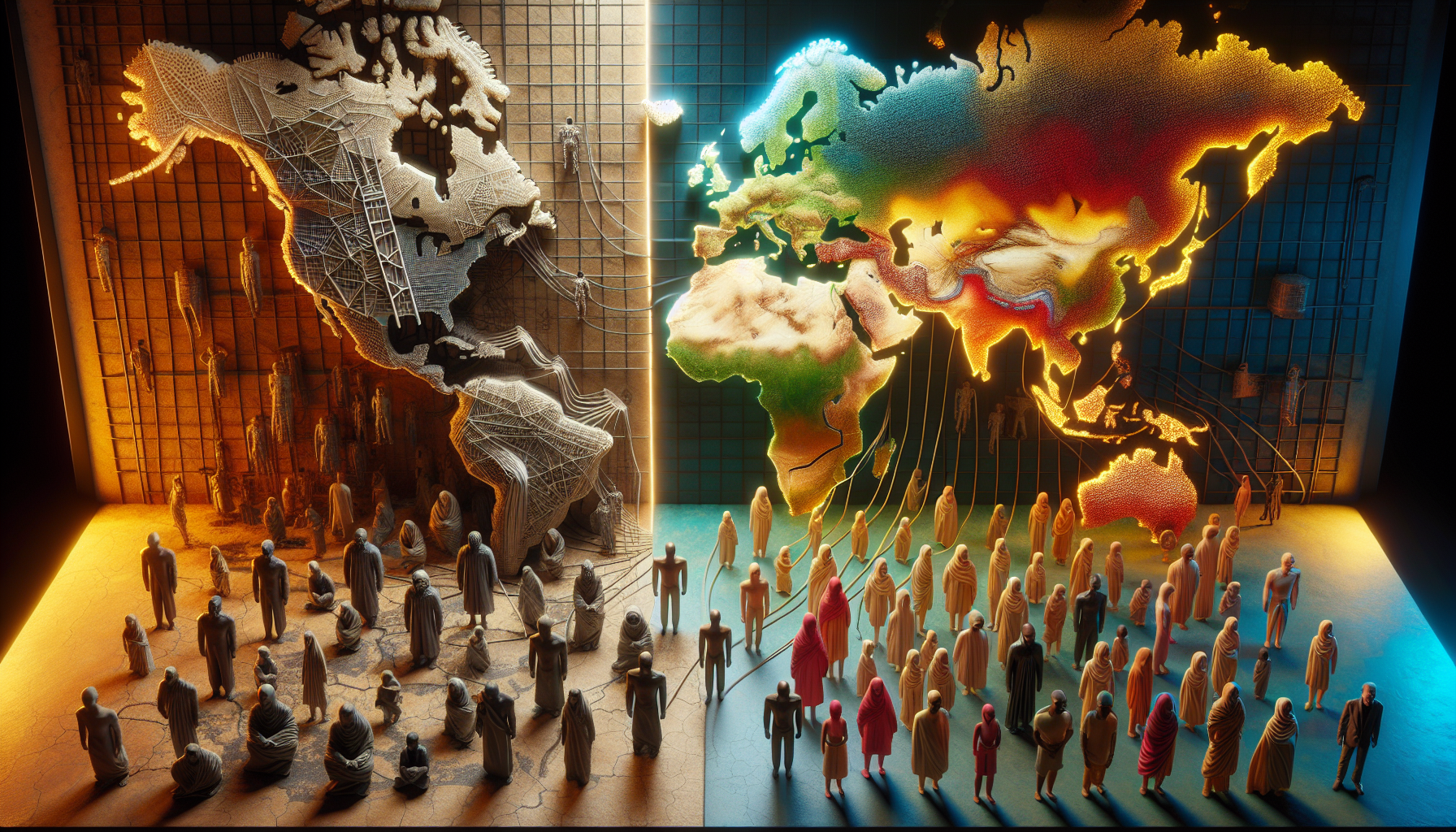Реклама
Реклама
Реклама
As we embark on this exploration of alternative cartography, we will delve into several key areas that illuminate its transformative potential. First, we will examine the historical context of map-making, highlighting how traditional maps have often perpetuated colonial and exclusionary narratives. This will set the stage for understanding why a reimagining of cartographic practices is not just beneficial but necessary. Next, we will explore innovative examples of alternative maps that prioritize inclusivity and equity, such as participatory mapping initiatives that give agency to local communities, and digital platforms that offer dynamic, interactive experiences. These case studies will illustrate how alternative cartography can reshape our perceptions of borders and inequality, fostering a more just and equitable global landscape.
Introduction to Alternative Cartography
The impact of alternative cartography is multifaceted. On one hand, it disrupts traditional power dynamics by questioning how borders are drawn and who benefits from them. On the other, it offers a platform for marginalized communities to redefine their identities and territories. This dual focus not only expands our understanding of geography but also prompts us to rethink political, social, and economic boundaries. The implications for global inequality are significant, as these maps have the potential to democratize knowledge and empower previously overlooked populations.
As we venture into the realm of alternative cartography, it’s essential to acknowledge the technological advancements that have made this possible. The digital age has revolutionized the way maps are created, distributed, and interacted with. Tools such as Geographic Information Systems (GIS), remote sensing, and interactive platforms have expanded the possibilities for map-making, allowing for unprecedented precision and personalization.
GIS technology, for instance, enables the integration of diverse data sets into a single map, providing users with a comprehensive view of geographical areas. This capability is particularly useful for addressing issues of inequality, as it allows for the visualization of socio-economic data alongside geographical features. Similarly, remote sensing technologies offer real-time insights into environmental changes, enabling the mapping of dynamic phenomena such as deforestation or urban expansion.
The Role of Community-Driven Cartography
One of the most exciting developments in alternative cartography is the rise of community-driven mapping projects. These initiatives prioritize local knowledge and perspectives, challenging the top-down approach traditionally employed in cartography. By involving community members in the map-making process, these projects aim to create more accurate and representative maps that reflect the lived realities of the areas they depict.
For instance, indigenous communities have utilized alternative cartography to assert their territorial rights and protect their ancestral lands from encroachment. By mapping their traditional territories and documenting their cultural sites, these communities have strengthened their claims and gained recognition from governments and international organizations. This approach has also been adopted by urban communities seeking to address issues such as housing inequality, access to services, and environmental justice.
Case Study: Mapping Inequality in Urban Areas
In urban settings, alternative cartography has been used to highlight patterns of inequality and advocate for change. Projects such as the “Mapping Prejudice” initiative in Minneapolis have revealed the historical legacy of redlining and racial segregation by digitizing property records and visualizing discriminatory housing practices. These maps have sparked conversations about systemic racism and spurred policy changes aimed at addressing these disparities.
Moreover, community-driven mapping projects have provided a platform for marginalized groups to share their experiences and amplify their voices. By documenting issues such as food deserts, lack of public transportation, and environmental hazards, these maps have become powerful tools for advocacy and reform. As a result, they have contributed to more equitable urban planning and resource allocation.
Challenging Traditional Borders
Alternative cartography also plays a critical role in challenging traditional concepts of borders. Political boundaries, often drawn without consideration for cultural, linguistic, or ecological factors, have historically been sources of conflict and division. By reimagining these borders, alternative cartography offers a more nuanced understanding of geographical areas and their inhabitants.
In addition to ecological considerations, alternative cartography also explores cultural and linguistic boundaries. By highlighting areas of cultural overlap and diversity, these maps challenge the notion of homogenous nation-states and promote a more inclusive understanding of identity. This perspective is particularly relevant in regions with significant ethnic diversity or historical conflict.
As alternative cartography continues to evolve, it raises important questions about sovereignty, identity, and governance. By providing new frameworks for understanding and negotiating borders, these maps have the potential to transform political discourse and promote more peaceful coexistence.
Comparative Analysis: Traditional vs. Alternative Maps
The table below provides a comparative analysis of traditional and alternative maps, highlighting key differences in their approach and impact:
| Аспект | Традиционные карты | Alternative Maps |
|---|---|---|
| Цель | Navigation and territorial definition | Exploration of borders and inequalities |
| Methodology | Top-down, expert-driven | Bottom-up, community-driven |
| Data Sources | Official records and surveys | Diverse data, including local knowledge |
| Focus | Geopolitical boundaries | Cultural, ecological, and social factors |
| Влияние | Reinforcement of existing power structures | Empowerment and social justice |
For a deeper dive into how alternative cartography is redefining borders, consider watching this informative video: “Redefining Borders: New Approaches in Modern Mapping” – Geography Now.
Заключение
In conclusion, the exploration of alternative cartography presents a transformative perspective on how we perceive and interact with the world. By reimagining geography, we challenge the conventional notions of borders and address the deep-seated inequalities perpetuated by traditional maps. Throughout this article, we’ve delved into the multifaceted role of maps in shaping political, economic, and social landscapes. We’ve highlighted the innovative ways in which alternative cartography can subvert established narratives, offering a more inclusive and equitable vision of our world.
One of the primary points discussed is the historical context of cartography, where maps have often been tools of power, reflecting the interests and biases of those who create them. Traditional maps tend to reinforce boundaries that divide, emphasizing nation-states’ sovereignty at the expense of cultural and regional fluidity. This conventional approach can exacerbate tensions and inequalities, as it often overlooks the realities of marginalized communities and indigenous peoples.
Alternative cartography, on the other hand, offers a fresh lens through which to view our planet. By embracing different perspectives—whether through artistic expression, technological innovation, or community-driven projects—we can create maps that tell diverse stories. These maps have the potential to highlight issues of social justice, environmental concerns, and cultural diversity, thereby fostering greater empathy and understanding among people.
The importance of this theme cannot be overstated. In a world increasingly characterized by globalization and interconnectivity, the way we perceive geographical boundaries has profound implications. Alternative cartography encourages us to rethink these borders, promoting a vision of the world that prioritizes human connections over divisions. It invites us to consider geography not as a static framework, but as a dynamic and evolving entity shaped by human experiences and relationships.
As we reflect on the potential of alternative cartography, it’s essential to recognize its power to influence policy and societal change. By illuminating the often-invisible lines of inequality and exclusion, these new maps can serve as catalysts for dialogue and action. They can inspire policymakers, educators, and activists to address the root causes of disparity and work towards a more just and equitable world.
We encourage you, our readers, to engage with this topic further. Consider how maps influence your understanding of the world and the assumptions they embed. Share your thoughts and experiences, and explore how alternative cartography can be integrated into educational curriculums, public discourse, and personal exploration. Let’s continue the conversation about how we can collectively reshape our understanding of geography to reflect a more inclusive global community.
Feel free to explore the following resources for further reading and inspiration:
1. The Power of Maps: https://www.jstor.org/stable/40154044
2. Mapping for Social Justice: https://www.tandfonline.com/doi/full/10.1080/1369118X.2020.1761859
3. Decolonizing the Map: https://www.taylorandfrancis.com/books/mono/10.4324/9780429299044
Thank you for embarking on this journey with us. Your curiosity and engagement are vital in reimagining how we understand and interact with our world. Keep exploring, questioning, and mapping new paths toward a future where borders are bridges rather than barriers.

Тони Сантос цифровой картограф, визуальный мыслитель и куратор всего удивительно странного. В Айсапп, он погружается в дикий мир причудливые карты, воображаемые географические объекты и альтернативные картографические реальности, предлагая свежий взгляд на то, как мы видим и чувствуем мир вокруг нас.
Его работа основана на убеждении, что Карты — это больше, чем просто инструменты навигации. Это порталы к восприятию, памяти, воображению и даже мифу. От искаженных исторических карт до сюрреалистических форм рельефа, атласов заговоров и созданных искусственным интеллектом миров, Тони создает и собирает карты, которые бросают вызов логике и пробуждают любопытство..
Имея опыт повествования, искусства и символического исследования, Тони использует Aysapp как платформу для раскрытия забытые места, невидимые границы и переосмысленные реальности. Его творения задают такие вопросы: что, если бы мир перевернулся? Что, если бы карты рассказывали эмоциональную правду вместо географической?
Как создатель Айсапп, он находится на миссии пробуждать любопытство, поощряйте творческое мышление и исследуйте пересечение воображения, культуры и пространственного повествования — по одной странной карте за раз.
-
Нереальные, но значимые пейзажи
-
Эмоции, память и миф как география
-
Карты, которые искажают, чтобы раскрыть скрытые истины
Являетесь ли вы поклонником фантастических стран, коллекционером карт, любопытным путешественником или любителем всего необычного, Тони намеренно приглашает вас затеряться в самых необычных уголках картографического воображения.











